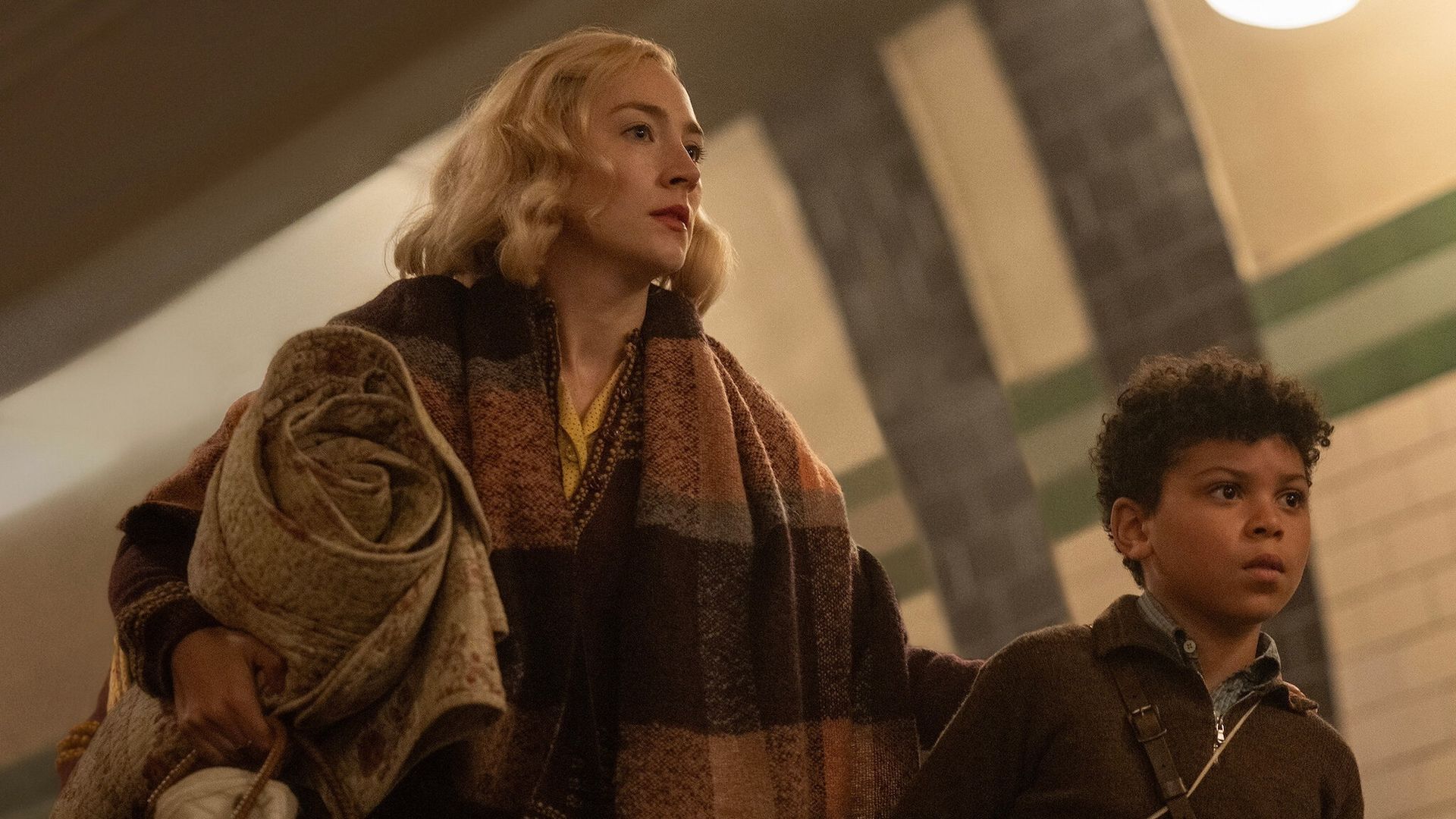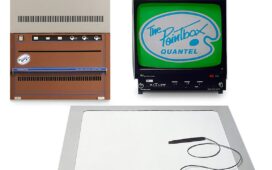To experience Bass (2024), Steve McQueen’s current installation at Dia Beacon, visitors descend into the museum’s basement and step into a liminal space. Sixty evenly spaced lightboxes on the ceiling cycle through the colour spectrum, as towers of speakers play an improvised composition evoking the rhythms that were carried to the West from Africa in the hulls of ships making the Middle Passage.
As McQueen told The Art Newspaper earlier this year: “For me it was about being in this state of limbo. The space between the crossing: that particular state of not arriving, and leaving, and what that is. The bassists are all from different aspects or places of the diaspora—from Africa, from America, from the Caribbean—and here they all come together to investigate, to interpret or just feel that idea of being in this place or non-place, whatever you want to call it.”
Blitz (2024), McQueen’s new feature film, is likewise concerned with subterranean spaces and deep bass rumble: it’s set in London during the Battle of Britain, and recreates the population’s nightly retreat to the stations of the Underground, where they sheltered in place, in a “state of limbo” while the lights flickered and the walls shook as German bombs rained down on the streets above. In this telling, what Churchill called Britain’s “finest hour” was also a moment at which the nation’s culture was, literally, subculture; every class, literally an underclass. London became a site of trauma, of the kind usually pushed to—or, more precisely, visited upon—the margins of empire. The radical solidarity this engendered, with class and racial lines redrawn around a shared experience of violence, was, McQueen argues in his intermittently quite powerful, frequently frustrating film, the Blitz’s squandered promise.
Blitz opens in the heat of the moment, on a street of terraced houses already engulfed in flames; when a fireman opens a hose the water bursts forth with such force that it knocks him out, and the spurting hose dances up and down the street like a snake, beyond the control of the ineffectual fire brigade. Though McQueen takes on weighty historical subjects—in Hunger, the Troubles; in Twelve Years a Slave, the “Peculiar Institution”; in the Small Axe films, Black British life—his films place the viewer in a visceral present tense. He constructs his films out of action setpieces that he mounts in clinical and impressive wide shots or unbroken takes, prioritising the experiential, as in his installation practice. The lack of context or foregrounded perspective can be alienating and unsettling, collapsing the distance between past and present and resisting the certainties of historical hindsight.
In that opening sequence, the clocktower of a neighbourhood church is destroyed; it is intact again in the following scenes, which introduce Rita (Saoirse Ronan), the white single mother of a Black son, George (Elliott Heffernan), at home in the same East London neighbourhood. The film has almost a countdown structure, unfolding over the course of several days and nights broken up by the rhythm of sirens and all-clears, flowing inexorably toward the flash-forward opening. An early bombing raid is a choreography of panic, hatted extras pouring through the locked gates of the Stepney Green station, down the stairs past the vintage adverts, the artificial light below ground at once dim and harsh against white subway tiles. Amidst such chaos, the family unit—Rita, George and Rita’s father (Paul Weller)—is the closest thing to security there is, but it’s not much, and the next morning Rita chooses to put George on a train with other children being evacuated to the countryside. He doesn’t want to go, and fights with his mother at the station; after racist taunting from the other boys on the train, he leaps off mid-journey to find his way back home.
As he did in Widows, McQueen explores the distance in the understanding of the world between parents and their biracial children. George’s anger at his mother for sending him away, and his desire to return to her, are not just a child’s clinginess, or guilt over his last words to her being “I hate you”—it reflects his hurt and fear that his mother is expelling him from the realm of protection offered by her whiteness, a protection he feels more acutely than she can.
As mother and child find their way back to each other, McQueen crosscuts between Rita’s archetypal experiences—as one of the kerchiefed women working at a factory, trading barbs on the assembly line and down at the pub; as one of the working-class; as one voice among the working-class chorus singing “Show Me the Way to Go Home” to drown out the sounds of war—and George’s child’s-eye-view odyssey. Blitz invokes common cultural memories of blacked-out windows and searchlights in the sky, but recentres the story around a different perspective, with new stories, new people, pulled forward from the background. It’s a historical pageant, a moving version of the colonial dioramas George takes in while wandering the “Empire Arcade”, but with a new cast and new emphasis. Flashbacks to George’s childhood bullying, to the multiracial nightlife of interwar London, recolour an often-whitewashed history.
This lesson is frequently underlined. On one night of the Blitz, George is shepherded through the city after curfew by a Nigerian warden (Benjamin Clémentine) who also defuses racial tensions in a shelter with a speech about how there is “no segregation here”. In her shelter, Rita listens to a Jewish socialist little person (Leigh Gill) deliver a rabble-rousing speech about how “maybe Jesus was a Red”. Both orations feel didactic and obvious in ways that go beyond the dictates of the genre McQueen is working in, which grants plenty of leeway for moral instruction and stirring corniness. The banter McQueen scripts for Rita and her coworkers, for George and the scampy boys he meets while hopping his train, comes off tinny, like nobody’s heart is really in this populist pastiche. Nor is the approach of reinserting multicultural Britain into the official record as subversive as the film wants it to be: even in the decade or so before Small Axe, the British Heritage template had begun to accommodate and even herald a more inclusive vision of the past. At its most flat-footed, Blitz resembles the episodes of Doctor Who in which the Time Lord’s BAME (Black, Asian and Minority Ethnic) companions discover that they aren’t the only people of colour at Shakespeare’s Globe, say, or the Thames Frost Fair.

Saoirse Ronan and Elliott Heffernan in a scene from Blitz (2024) Apple TV+
The premise of a parent and child wrenchingly separated in the turmoil of war is pure Spielberg—Blitz is particularly reminiscent of Empire of the Sun, even down to the gang of black marketeers with whom George briefly falls in—but McQueen goes flat whenever he tries to hit Spielbergian notes. Sentimental scenes like Rita bravely ministering to a frightened substitute child in a shelter are rote and obligatory, and McQueen, who at his best has a brilliant, confrontational way with sound design, outsources much of the emotion to Hans Zimmer’s heavily signifying score. His screenplay teeters between well-constructed and mechanistic—the ending might feel inevitable, rather than predictable, if it could hit its marks without looking down at the strike tape.
What McQueen does measure up to is the riskier, surreal side of Empire of the Sun, a film whose impressions of the Second World War come through in almost overwhelmingly vivid, confusing moments of skewed and morbid wonderment. This is particularly so in some third-act setpieces that McQueen stages with his characteristic remove, like the awful crush at a locked gate during a tube-station flood based on the Balham disaster, or a masterful tracking shot through a recreation of the Café de Paris nightclub, in which the camera dances champagne-drunk between kitchen, dining room and bandstand, on a Jazz Age set more glamorous than history ever was. The Café de Paris scene arrives almost out of nowhere, as if dropped in from another movie, and the grotesque irony of its payoff is effective because it’s almost entirely outside the story, like a memory snatched at. In stripping away the scaffolding of narrative, McQueen returns to the flux of events—to the space between, the crossing.
Often, the narrative he strips away is historical myth. A film of cozy woollens and precious memories, Blitz is full of nostalgic textures, but practically every texture save the knitwear rubs you the wrong way. When the factory girls draw lines on the back of their calves to imitate the seams of scarce nylons, they joke about cheating on their soldier boyfriends. Keep calm and carry on, hell: at first, the authorities block the gates of the Underground during bombing raids, keeping out the huddled masses; when the gates open, people push and shove each other out of the way, knocking over women and children (McQueen was inspired by an incident, largely suppressed at the time, during which dozens died in a crush at the Bethnal Green tube station). This is the film’s more successful strand of historical revisionism:What did you do in the war, dad? Nothing quite so romantic as the story that would later be told; with every anecdote given a twist of human weakness or outright venality, Blitz confronts the illusions of a society that does not deserve them.
Early in the film, a voice on the wireless describes the Nazis’ nightly bombings as “terror raids”, a startling phrase that clarifies the position of the British people as passive victims of indiscriminate state violence—they are suddenly subaltern, subject to death from above, in a literal and sociopolitical sense. (At some point this awards season, I would love for someone to ask McQueen if he wants this film about citizens living under constant bombardment to remind his viewers of the plight of Palestinians in Gaza; I wonder if he would answer.) It is significant that Rita’s part in the war effort is her job in a munitions factory: British bombs will win the fight against Hitler, yes, but they also created the terror by which imperial hegemony was enforced both before and after the war, and this knowledge sours and complicates the film.
“Nothing makes sense. Nothing makes sense,” McQueen said in an interview last year, pushing back against a critic’s claim that there was any particularly intentional meaning contained within a suggestive juxtaposition in his Second World War documentary Occupied City. He prizes immersion over interpretation, and at its best, Blitz makes its audience forget what we know about Britain and simply feelthe terror. Within that feeling is, on one hand, the atavistic survival instinct, but on the other hand a shared vulnerability and the possibility of mutual care, a recognition that everyone is equal in “feel[ing] that idea of being in this place or non-place, whatever you want to call it”. But at the same time, McQueen knows that his country did not hold onto this feeling.
In addition to Bass, Blitz is in dialogue with another recent gallery piece of McQueen’s: Grenfell, composed of footage of the ruins of Grenfell Tower, the public housing estate in the monied Royal Borough of Kensington and Chelsea, which burned in 2017, killing 72 residents in a disaster that was widely seen as an indictment of the impoverishment and abandonment of Britain’s working classes and ethnic minorities. In Blitz, as we look out at recurrent images of London homes reduced to rubble, we begin to think about a legacy of ashes that, in the coming decades, would be distributed far less indiscriminately than it was during the Battle of Britain.
- Blitz is currently playing in wide release at cinemas in the US and in limited release in the UK. It is also available to stream on Apple TV+








